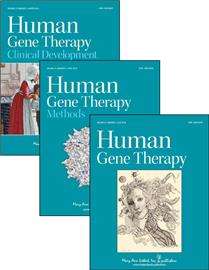Credit: Mary Ann Liebert, Inc., publishers
A new gene therapy approach designed to replace the enzyme that is deficient in patients with the inherited neurodegenerative disorders Tay-Sachs and Sandhoff diseases successfully delivered the therapeutic gene to the brains of treated mice, restored enzyme function, and extended survival by about 2.5-fold. The implications of these promising results for developing similar gene therapies for use in hu-mans and for targeting additional brain disorders are discussed in two articles published in Human Gene Therapy.
Both studies demonstrate the feasibility and efficacy of gene transfer in preclinical models. The articles are entitled "Novel Vector Design and Hexosaminidase Varieant Enabling Self-Complementary Adeno-Associated Virus for the Treatment of Tay-Sachs Disease", by Karumuthil-Melethil, et al.; and "Systemic Gene Transfer of a Hexosaminidase Variant Using a scAAV9.47 Vector Corrects GM2 Gangliosidosis in Sandhoff Mice", by Osmon et al.
Steven Gray, University of North Carolina at Chapel Hill, and Jagdeep Walia, Queen's University (Kingston, Canada), led a team of researchers from SickKids and University of Toronto (Canada), New Hope Research Foundation (North Oaks, MN), and University of Mannitoba (Winnipeg, Canada), in the successful development of a specialized adeno-associated virus (AAV) vector designed to deliver a gene coding for portions of the alpha and beta subunits of the enzyme that are defective in the Tay-Sachs and Sandhoff mice, respectively. The novel gene transfer vector, administered intravenously, was able to deliver the therapeutic gene to the brain and spinal cord, the targeted site of action.
"This important proof-of-concept study sheds important information on the optimal design of rAAV vectors for this class of disorders," says Editor-in-Chief Terence R. Flotte, MD, Celia and Isaac Haidak Professor of Medical Education and Dean, Provost, and Executive Deputy Chancellor, University of Massachusetts Medical School, Worcester, MA.
More information: Subha Karumuthil-Melethil et al. Novel Vector Design and Hexosaminidase Variant Enabling Self-Complementary Adeno-Associated Virus for the Treatment of Tay-Sachs Disease, Human Gene Therapy (2016). DOI: 10.1089/hum.2016.013
Karlaina J.L. Osmon et al. Systemic Gene Transfer of a Hexosaminidase Variant Using an scAAV9.47 Vector Corrects GGangliosidosis in Sandhoff Mice, Human Gene Therapy (2016). DOI: 10.1089/hum.2016.015
Journal information: Human Gene Therapy
Provided by Mary Ann Liebert, Inc























